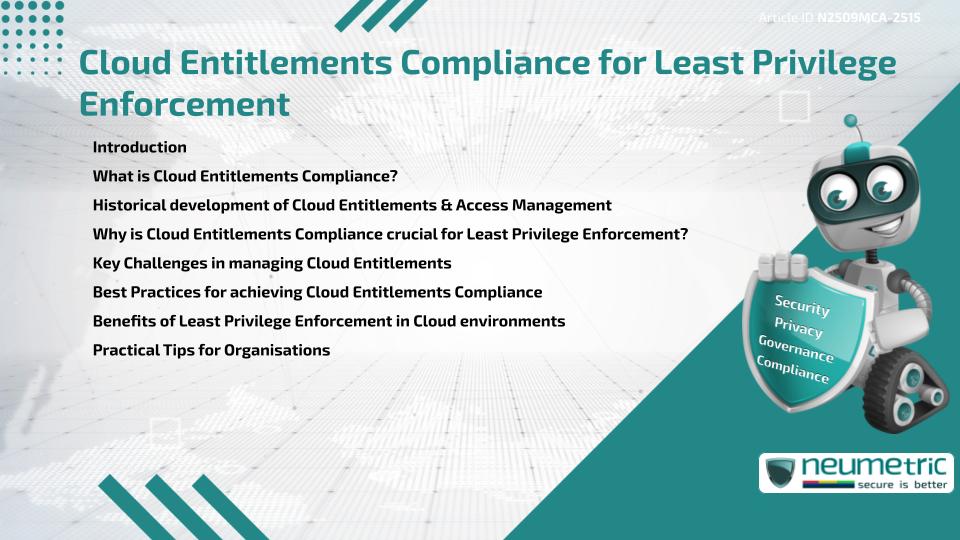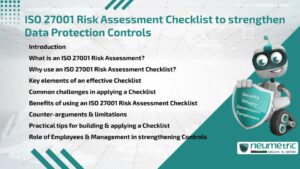Table of Contents
ToggleIntroduction
Cloud Entitlements Compliance refers to the Governance & Monitoring of access rights within Cloud environments to ensure adherence to Security & Regulatory Standards. It plays a critical role in implementing the principle of Least Privilege, where users & applications receive only the access necessary for their tasks. With the rapid adoption of multi-Cloud services, poorly managed Entitlements have become a leading cause of Data Breaches & Compliance failures. This article explains what Cloud Entitlements Compliance is, its historical background, its importance for least privilege enforcement, challenges, Best Practices & practical tips for Organisations.
What is Cloud Entitlements Compliance?
Cloud Entitlements Compliance ensures that permissions assigned to users, roles & applications in the Cloud align with organisational Policies & external Regulations. Cloud environments often rely on Identity & Access Management [IAM] services, which provide fine-grained permissions. However, misconfigurations & over-privileged accounts can create significant Risks.
Compliance in this context means continuously Auditing, Monitoring & adjusting Entitlements to avoid excessive privileges while still enabling productivity.
Historical development of Cloud Entitlements & Access Management
The concept of Entitlements dates back to traditional IT systems where administrators managed permissions through role-based Access Control [RBAC]. As Organisations moved to the Cloud in the 2010s, providers like Amazon Web Services [AWS], Microsoft Azure & Google Cloud Platform introduced IAM frameworks.
Initially, IAM tools provided basic functions such as User management & Policy creation. Over time, as Cloud complexity grew, the challenge shifted to managing thousands of Entitlements across distributed workloads. This led to the emergence of Cloud Infrastructure Entitlement Management [CIEM] solutions, which automate & enforce Compliance with least privilege principles.
Why is Cloud Entitlements Compliance crucial for Least Privilege Enforcement?
The principle of least privilege limits the damage from insider Threats, compromised Credentials or accidental misuse by ensuring accounts only have necessary access. Cloud Entitlements Compliance is essential because:
- Excess Entitlements can give attackers broad access if a single account is compromised.
- Regulatory frameworks such as GDPR, HIPAA & PCI DSS require strict Access Controls.
- Over-privileged accounts are among the top misconfigurations exploited in Cloud breaches.
By enforcing Compliance, Organisations reduce their attack surface & improve Trust with Customers & Regulators.
Key Challenges in managing Cloud Entitlements
Organisations face several obstacles when striving for Cloud Entitlements Compliance:
- Complexity of multi-Cloud environments: Each provider has unique IAM structures.
- Over-privileged roles: Developers or admins often receive more access than required.
- Shadow IT: Unauthorised use of Cloud resources bypasses Compliance checks.
- Dynamic environments: Permissions change frequently in agile & DevOps workflows.
- Limited visibility: Without specialised tools, tracking Entitlements across Clouds is difficult.
These challenges highlight the need for structured Governance & Automation.
Best Practices for achieving Cloud Entitlements Compliance
To achieve strong Compliance & support Least Privilege Enforcement, Organisations should adopt these practices:
- Perform entitlement discovery: Map all permissions across Cloud accounts to identify unused or risky Entitlements.
- Apply the principle of least privilege: Grant temporary or just-in-time access instead of permanent permissions.
- Automate policy enforcement: Use CIEM or IAM tools to detect & correct misconfigurations.
- Conduct regular Audits: Review access logs & entitlement reports to ensure alignment with Policies.
- Integrate Compliance into DevOps: Build entitlement checks into CI/CD pipelines to prevent violations before deployment.
- Educate users & administrators: Awareness reduces accidental over-provisioning & policy violations.
Benefits of Least Privilege Enforcement in Cloud environments
When Organisations align Cloud Entitlements Compliance with least privilege enforcement, they gain:
- Reduced Risk of insider misuse or external attacks.
- Stronger Regulatory Compliance & Audit readiness.
- Improved operational efficiency by removing redundant Entitlements.
- Increased trust from Customers & Stakeholders.
- Clear Accountability for access-related actions.
These benefits demonstrate how Compliance strengthens both security & business resilience.
Practical Tips for Organisations
To sustain Cloud Entitlements Compliance effectively, Organisations should:
- Start small by focusing on high-Risk accounts & gradually expanding.
- Use automation to reduce manual effort & human error.
- Continuously monitor Entitlements with real-time alerts for Policy violations.
- Align entitlement management with broader Governance, Risk & Compliance programs.
- Treat Compliance as an ongoing process rather than a one-time project.
Conclusion
Cloud Entitlements Compliance is fundamental for enforcing least privilege in modern Cloud environments. It reduces Risks, ensures Regulatory adherence & strengthens Security posture. Despite challenges such as complexity & visibility gaps, adopting Best Practices, leveraging CIEM tools & fostering a culture of Compliance can help Organisations achieve sustainable success.
Takeaways
- Cloud Entitlements Compliance ensures permissions align with Policies & Regulations
- It is essential for enforcing least privilege & reducing attack surfaces.
- Common challenges include multi-Cloud complexity & over-privileged accounts.
- Best Practices involve discovery, automation, auditing & training.
- CIEM platforms & IAM tools are key enablers of Compliance.
FAQ
What is Cloud Entitlements Compliance?
It is the process of governing, auditing & adjusting access rights in Cloud environments to ensure adherence to Policies & Regulations.
Why is least privilege important in the Cloud?
It minimises the Risk of breaches by ensuring users & applications only have the access they need.
What tools support Cloud Entitlements Compliance?
CIEM solutions & Cloud-native IAM services help monitor & manage Entitlements.
How often should Entitlements be reviewed?
They should be reviewed regularly, ideally quarterly or after major organisational changes.
Can Cloud Entitlements Compliance help with regulatory audits?
Yes, maintaining Compliance demonstrates adherence to standards like GDPR, HIPAA & PCI DSS.
What Risks arise from poor entitlement management?
Over-privileged accounts, misconfigurations & shadow IT increase the Risk of breaches.
How does automation help in entitlement management?
Automation detects unused or risky Entitlements, enforces Policies & reduces manual errors.
Need help for Security, Privacy, Governance & VAPT?
Neumetric provides organisations the necessary help to achieve their Cybersecurity, Compliance, Governance, Privacy, Certifications & Pentesting needs.
Organisations & Businesses, specifically those which provide SaaS & AI Solutions in the Fintech, BFSI & other regulated sectors, usually need a Cybersecurity Partner for meeting & maintaining the ongoing Security & Privacy needs & requirements of their Enterprise Clients & Privacy conscious Customers.
SOC 2, ISO 27001, ISO 42001, NIST, HIPAA, HECVAT, EU GDPR are some of the Frameworks that are served by Fusion – a SaaS, multimodular, multitenant, centralised, automated, Cybersecurity & Compliance Management system.
Neumetric also provides Expert Services for technical security which covers VAPT for Web Applications, APIs, iOS & Android Mobile Apps, Security Testing for AWS & other Cloud Environments & Cloud Infrastructure & other similar scopes.
Reach out to us by Email or filling out the Contact Form…





